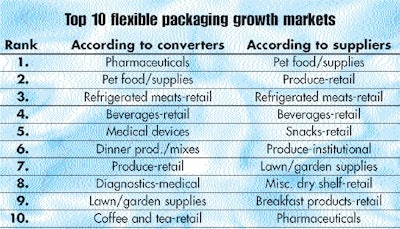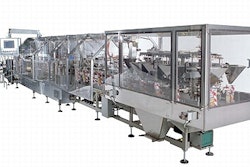
Accounting scandals, a tightening energy market, rising resin prices, and talk of war in Iraq all helped characterize 2002 as “turbulent, outlandish, and unpredictable,” says the Executive Summary in State of the Industry Report 2003 from the Flexible Packaging Assn. That’s the bad news.
The good news is that FPA projects 2003 flexible shipments to grow 4.2% this year to $20.8 billion. Factors contributing to the growth are similar to those cited in last year’s FPA report (see
packworld.com/go/c080). On the materials side, those factors include more use of rollstock in multiweb combinations (excluding paper/paper) and plastic bags. Trends driving the growth of flexibles include “changing demographics, new product introductions, and a consumer thirst for convenience.”
Citing The Food Institute’s research, FPA projects that population growth in the United States will rise by two to three million people per year between now and the year 2020. As a result, the forecast says, “Consumers will continue to demand new food products, more convenience, more nutritional foods, and packaging to help deliver a fresher, safer food system.”
Beyond food, demand for flexible packaging materials will come from pet foods, health and beauty aids, lawn and garden supplies, pharmaceuticals, and medical devices. In surveying its converting and supplier members, FPA created a “Top 10” list of flexible packaging markets (Chart A).
Other charts accompanying this story include a value of flexibles by end-use market segment (Chart B), estimated flexible shipments by material type (Chart C), how flexible packaging fits into the overall U.S. packaging market by material segment (Chart D), and the growth of flexibles from 1992 to 2002 (Chart E).
The 187-page, spiral-bound report defines flexible packaging as “any package or part of a package whose shape can be readily changed.” FPA says that includes bags, pouches, liners, shrink wrap, bulk shipping sacks, rigid packaging membranes, and shrink-sleeve or film-wraparound labels.
FPA reports that the $20 billion flexible packaging “industry” employs some 87꼀 people in the U.S. According to the most recent United States Census Bureau statistics, there are nearly 450 flexible packaging companies in this country, accounting for about 955 plants.
The report says, “The consolidation of end users of packaging suppliers is largely responsible for the record volume of mergers and acquisitions a few years ago, despite the recent slow pace [of those actions]. Merger and acquisition activity is expected to continue as converters expand their operations to follow end users into international markets or to concentrate their efforts on local and regional niche markets.”
State of the Industry Report 2003 is free to FPA members, $3귔 to nonmembers.























